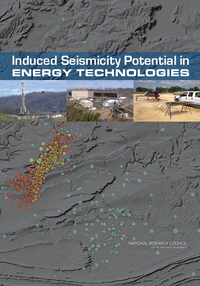
In the past several years, some energy technologies that inject or extract fluid from the Earth, such as oil and gas development and geothermal energy development, have been found or suspected to cause seismic events, drawing heightened public attention.
Although only a very small fraction of injection and extraction activities among the hundreds of thousands of energy development sites in the United States have induced seismicity at levels noticeable to the public, understanding the potential for inducing felt seismic events and for limiting their occurrence and impacts is desirable for state and federal agencies, industry, and the public at large. To better understand, limit, and respond to induced seismic events, work is needed to build robust prediction models, to assess potential hazards, and to help relevant agencies coordinate to address them.
Induced Seismicity Potential in Energy Technologies identifies gaps in knowledge and research needed to advance the understanding of induced seismicity; identify gaps in induced seismic hazard assessment methodologies and the research to close those gaps; and assess options for steps toward best practices with regard to energy development and induced seismicity potential.
About 60% of the energy consumed in the United States come from fluids pumped from the ground. Activities related to producing this energy, including conventional oil and gas drilling, hydraulic fracturing, geothermal energy production, and underground injection of wastewater, have been linked to a small number manmade earthquakes. This video, based on the NRC report, examines the scientific basis for manmade seismic activity and discusses practices that can help reduce risks.
The National Academies Press (NAP) has partnered with Copyright Clearance Center's Rightslink service to offer you a variety of options for reusing NAP content. Through Rightslink, you may request permission to reprint NAP content in another publication, course pack, secure website, or other media. Rightslink allows you to instantly obtain permission, pay related fees, and print a license directly from the NAP website. The complete terms and conditions of your reuse license can be found in the license agreement that will be made available to you during the online order process. To request permission through Rightslink you are required to create an account by filling out a simple online form. The following list describes license reuses offered by the National Academies Press (NAP) through Rightslink:
Click here to obtain permission for the above reuses. If you have questions or comments concerning the Rightslink service, please contact:
Rightslink Customer Care
Tel (toll free): 877/622-5543
Tel: 978/777-9929
E-mail: customercare@copyright.com
Web: http://www.rightslink.com
To request permission to distribute a PDF, please contact our Customer Service Department at 800-624-6242 for pricing.
To request permission to translate a book published by the National Academies Press or its imprint, the Joseph Henry Press, please click here to view more information.